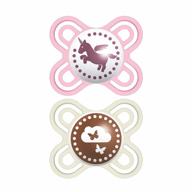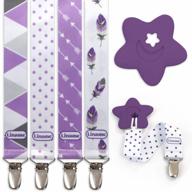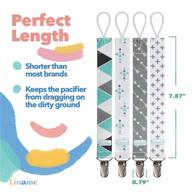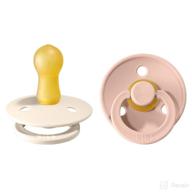Teething 101: Understanding Baby's Oral Discomfort
Teething is a normal part of infant development that typically begins around 6 months of age. However, some babies may start teething as early as 3 months, while others may not get their first tooth until 12, even 15 months. Teething occurs when a baby's teeth begin pushing through the gums as they grow in. This process can cause swelling, discomfort, and pain in a baby's mouth.
Signs of Teething
How do you know if your baby is teething? Here are some common signs and symptoms:
- Irritability and crying
- Disrupted sleep
- Drooling
- Chewing on objects
- Red or inflamed gums
- Swollen cheeks
- Biting
- Decreased appetite
Every baby experiences teething differently. Some show several symptoms while others display very few. Teething may come and go in cycles as teeth push through then rest before continuing to emerge. Pay attention to behavior changes as a clue that your baby is uncomfortable.
Teething Stages
Teething occurs in stages as different types of teeth come in:
| Age Range | Teeth |
|---|---|
| 6-12 months | Bottom front teeth (incisors) |
| 8-16 months | Top front teeth |
| 16-22 months | Top and bottom side teeth (canines and molars) |
The timing may vary, but this gives a general guide to expect as your baby's teeth emerge at different ages.
Soothing Teething Discomfort
While teething is a natural process, there are ways to minimize your baby's discomfort:
- Gently rub swollen gums with a clean finger or wet washcloth
- Allow chewing on a chilled (not frozen) teether
- Use an oral numbing gel or suspension under your pediatrician's supervision
- Give a pain reliever like infant acetaminophen if recommended by your doctor
With patience and attentive care, you can help make your baby's teething experience as smooth as possible.
Choosing the Right Pacifier: Tips for Finding the Perfect Fit
Pacifiers can be a useful tool to satisfy a baby's natural sucking instinct and provide comfort. Choosing the right pacifier for your child is key to ensure safety and acceptance.
Pacifier Materials
Pacifiers come in a variety of materials:
- Silicone - durable, easy to clean, dishwasher safe
- Latex - lightweight, flexible, affordable, but has potential allergy risk
- Plastic - hard, durable, easy to find, but not as flexible or baby-friendly
Silicone is considered the safest and most hygienic option. Look for one-piece construction with ventilation holes for safety.
Pacifier Shapes and Sizes
Variations in nipple shape and shield size can affect comfort and effectiveness:
- Nipple shape
- Round - good for most babies
- Orthodontic - flatter design promotes dental health
- Shield size
- Small - for newborns
- Large - for older babies
Try different options to see what appeals most to your baby.
Age Appropriateness
Pacifier guidelines change as baby grows:
| Age | Pacifier Recommendations |
|---|---|
| Birth to 6 months | Small, rounded orthodontic |
| 6 to 18 months | Rounded or orthodontic |
| 18+ months | Orthodontic recommended |
Follow manufacturer instructions for age and weight recommendations.
Safety Tips
Keep these precautions in mind for safe pacifier use:
- Never clip or tie pacifier to baby's clothing - this poses a strangulation hazard
- Use pacifier clips cautiously under supervision
- Inspect for cracks or tears and replace damaged pacifiers immediately
- Clean thoroughly between uses
- Never coat with honey or sweet liquids
With some informed trial and error, you can find the perfect pacifier to comfortably meet your baby's needs.
Teething Toys Galore: Soothing Baby's Gums with Safe Objects
Teething toys provide comfort, stimulation, and relief for babies during this uncomfortable phase. With so many options available, how do you choose the right ones? Here are some top teething toy picks to soothe your baby's tender gums.
Teether Types
Teethers come in a variety of shapes and textures:
- Ring - Easy grasp, circular shape, multifunctional
- Bristle - Nubby bristles massage gums
- Cloth - Soft, pliable, can be chilled
- Teething mitt - Worn on hand for access to chewing
Having different types on hand allows you to see which your baby responds to best.
Teething Toy Materials
Look for these baby-safe materials in teething toys:
- Silicone - Flexible, durable, easy to clean
- Wood - Natural feel, sustainable
- Rubber - Gentle texture, assorted shapes
- Cloth - Soft, freezable
- Water-filled - Soothes via cooling liquid
Avoid potential toxins like BPA, phthalates, lead, and latex.
Helpful Teething Toy Features
Specialized features can enhance teething relief:
- Vibrating - Provides massaging motion
- Textured surfaces - Massages swollen gums
- Water-filled - Can be chilled for cooling effect
- Rattle - Combination teether and toy
Look for BPA-free water chambers in teething toys meant to be chilled.
Safety First
Keep these safety guidelines in mind when selecting teethers:
- Avoid small parts that could pose a choking hazard
- Select BPA-free materials
- Check for sturdy construction without sharp edges
- Clean thoroughly between uses
- Discard at first sign of damage
With close supervision and toys designed with infant safety in mind, you can give your baby relief during this uncomfortable milestone.
Ending the Teething Tantrums: Ways to Soothe Your Cranky, Uncomfortable Baby
Teething can turn even the most mild-mannered baby into a temper tantrum-throwing ball of frustration. Those little teeth pushing through tender gums are the culprit behind their discomfort. While teething is a natural phase that will pass, here are some ways to help calm your upset baby in the meantime.
Medications
Medications can reduce teething pain and inflammation under medical supervision:
- Acetaminophen - Provide relief for aches and pain
- Topical anesthetics - Temporarily numb gums
- Homeopathic teething tablets - Contain natural active ingredients
Consult your pediatrician about proper dosing and usage instructions.
Cold Therapy
Gently cooling swollen gums can provide relief. Try these methods:
- Chilled teether or spoon
- Cold washcloth
- Frozen fruit in mesh feeder
Avoid direct ice contact or anything frozen to prevent injury.
Chewing and Gum Massage
Chewing motions can distract from discomfort:
- Rub gums gently with clean finger
- Allow chewing on teether toys
- Try a textured teething mitt for access to chewing
The pressure and rubbing soothes irritated gums.
Other Comfort Measures
Additional ways to calm your teething baby include:
- Holding
- Rocking
- Bathing
- Soft music
- Massage
- Distraction with toys
Your loving comfort is soothing during this difficult transition. With your attentive care and these measures to relieve pain, the tantrums and tears will pass.
Cleaning and Caring for Pacifiers: Keeping Them Hygienic and Functional
Pacifiers provide comfort and security for many babies. With frequent use, pacifiers need thorough cleaning to prevent the spread of germs and maintain functionality.
Daily Cleaning
Clean pacifiers at least once per day and during use as needed. Recommendations include:
- Wash with hot, soapy water after each use. Avoid abrasive sponges.
- Rinse thoroughly with hot water to remove all soap residue.
- Allow to air dry completely before next use. Do not put in mouth while wet.
For example, clean your baby's pacifier after dropping on the floor by washing, rinsing, and allowing to dry.
Deep Cleaning
Perform more thorough disinfecting periodically:
- Soak in boiling water for 5 minutes.
- Use a pacifier sterilizer or steam sterilization bags.
- Wash in dishwasher for full sanitation cycle.
Deep clean pacifiers weekly or whenever your baby has been sick to prevent reinfection.
Inspection and Replacement
Check pacifiers frequently and replace when needed:
- Look for cracks, tears, and perforations in nipple.
- Ensure all pieces fit tightly together.
- Replace pacifiers every 1-2 months with heavy use.
Replace pacifiers immediately if nipple becomes sticky, deformed, or has any other damage.
Safe Storage
Proper storage prevents contamination between uses:
- Keep in clean, dedicated pacifier holder not touching other surfaces.
- Store separately from diaper bags to avoid cross-contamination.
- Do not rinse or store in unsanitary liquids.
With regular cleaning and replacement as needed, pacifiers can be safely used to comfort babies.
Teething Remedies: Natural and Medicinal Options for Relief
Teething can cause pain, fussiness, and discomfort in babies. Both natural and medicinal remedies can provide relief during this developmental phase.
Natural Remedies
Some gentle, natural options to soothe teething discomfort include:
- Chilled teething rings - Cool temperature numbs pain
- Frozen fruit or vegetables - Apple slices or carrots can be rubbed on gums
- Cold spoon or washcloth - Apply cooling pressure to swollen areas
- Teething toys - Distraction and chewing action eases irritation
For example, a chilled silicone teether from the refrigerator can calm inflammation for a teething baby.
Medicinal Remedies
Medications can reduce teething symptoms under medical guidance:
- Acetaminophen - Eases pain as needed per weight and age
- Topical anesthetics - Temporarily numb gums
- Homeopathic teething tablets - Provide natural active ingredients
- Oral pain relieving gels - Apply directly to gums
Consult your pediatrician to ensure proper usage and dosage for medicinal teething aids.
Safety Considerations
Keep safety in mind when using remedies:
- Never apply Orajel or gels without medical approval
- Use proper dosing of acetaminophen based on age/weight
- Avoid teething tablets with belladonna
- Never freeze liquid-filled teethers
Proper usage and supervision ensures these remedies safely ease your baby's discomfort.
Additional Tips
Try these extra measures alongside remedies:
- Gently rub gums with clean finger
- Provide gum massage
- Use teething mitts allowing access to hands
- Improve fussiness with cuddling, rocking, cold towels
With a combination approach, your baby's teething experience can be more comfortable.
How to use your Amazon Prime to buy "Pacifiers, Teethers & Teething Relief"
Amazon Prime offers fast, free shipping and convenient delivery options for buying essential baby items like pacifiers and teething relief products. Follow these steps to utilize your Prime membership benefits when purchasing these items.
Browse Pacifier and Teether Selection
Log into your Amazon Prime account on Amazon.com or using the mobile app. Search for "pacifiers" or "teethers" and browse the extensive selection of options. Amazon carries trusted baby brands like Philips Avent, NUK, MAM, and Dr. Brown's as well as Amazon's own Solimo and Mama Bear product lines.
Use filters to narrow your search by price range, average rating, material (silicone, rubber, etc), and age range to find the best pacifiers and teethers to meet your needs.
Add Items to Cart
When you find pacifiers or teething toys you want to purchase, simply click "Add to Cart". Continue browsing and adding items to your cart until you have everything needed. Amazon will save your cart contents if you want to come back later before checking out.
Proceed to Checkout
When ready to purchase, click through to your cart and proceed to checkout. Make sure your shipping address is correct for delivery. As an Amazon Prime member, you'll see free one-day or two-day shipping speed options for your order.
Select FREE Prime Shipping
On the checkout page, be sure to select free Prime shipping as your delivery method. Other options like Amazon Day can take longer. Choose the fastest Prime free shipping choice to get your pacifiers and teething relief products as quickly as possible.
Complete Order
On the payment page, select your payment method and complete the checkout process. Orders over $25 qualify for free Prime shipping. You'll receive confirmation of your Amazon order and estimated delivery date.
Track Package
Once your order ships you can track your Amazon package to know exactly when to expect delivery. Sign up for delivery alerts as well. Pacifiers, teethers and other essential baby items will arrive quickly thanks to the shipping benefits of Amazon Prime!Following these simple steps allows you to conveniently and affordably shop for pacifiers, teethers and teething relief items shipped fast through your Prime membership.
Top products in 🍼 Pacifiers, Teethers & Teething Relief


19 Review

Find The Perfect Pacifier Or Teether For Your Baby's Teething Needs.
When it comes to finding the perfect pacifier or teether for your baby's teething needs, there are plenty of options available. Some popular choices include the RaZbaby RaZberry Silicone Baby Teether Toy, Nuby Ice Gel Teether Keys, and SoothiPop Silicone Teething Pacifiers. You can browse a wide selection of pacifiers, teethers, and teething relief products on Amazon, where you'll find top-rated items like the MAM Pacifier and the Nuby Teething Necklace.
What Are The Best Teething Toys For Babies?
Here are some of the best teething toys for babies, according to various sources:
When choosing a teething toy for your baby, it's important to consider factors such as material, design, and ease of cleaning. Some babies may prefer certain shapes or textures, so it may take some trial and error to find the right teether for your little one.
What Are The Pros And Cons Of Silicone Teething Toys?
Pros of silicone teething toys:
Cons of silicone teething toys:
Overall, silicone teething toys are a popular choice for parents due to their safety, ease of cleaning, and variety of textures and shapes. However, it's important to choose high-quality silicone teethers that are appropriate for your baby's age and development, and to monitor your baby while they are using the teether to ensure their safety.











